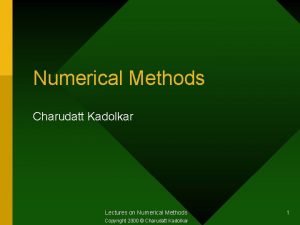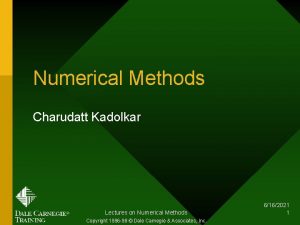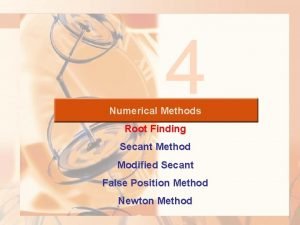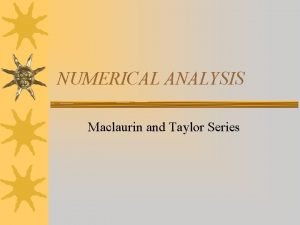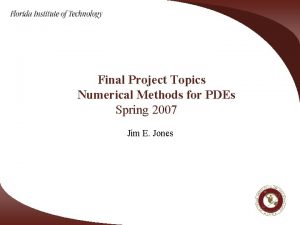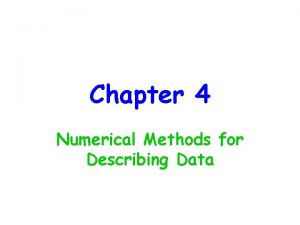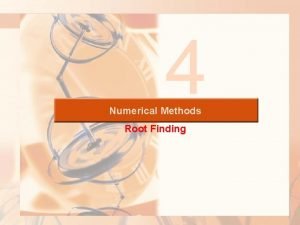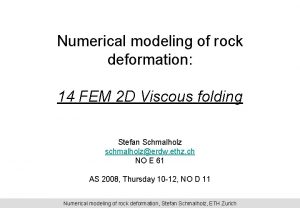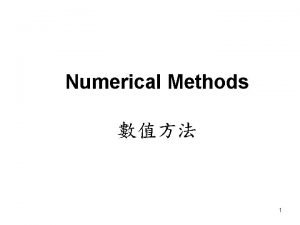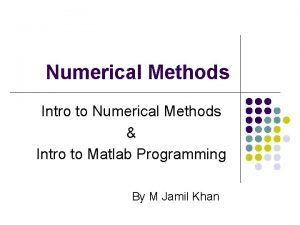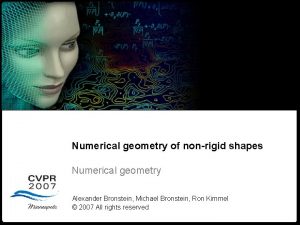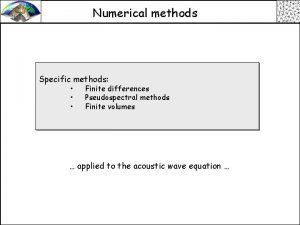Numerical Methods Charudatt Kadolkar Lectures on Numerical Methods










- Slides: 10

Numerical Methods Charudatt Kadolkar Lectures on Numerical Methods Copyright 1996 -98 © Dale Carnegie & Associates, Inc. 6/16/2021 1

Interpolation Problem – In general the function is known only for a few points or provided as a table. – Example: A log table only mentions following values. x 1 1. 5 2 3 3. 5 4 Log(x) 0. 0 0. 17609 0. 30103 0. 47712 0. 54407 0. 60206 – The problem is to find log(2. 5). We may use a straight line interpolation between points 2 and 3. – The straight line interpolation may be extended to a polynomial, since the straight line uses only two datapoints, when we have several data points available with us. – We will find a polynomial which passes through all these points. Lectures on Numerical Methods 6/16/2021 2

Polynomials Forms of Polynomials Lectures on Numerical Methods 6/16/2021 3

Polynomials • Nested Multiplication Algorithm – Want to evaluate a polynomial P(x) given in Newton form, at x = z. – 1. bn = an 2. For i = n – 1 to 0 step – 1 3. bi = ai + ( z – ci+1 )* bi+1 4. Print the answer P(z) = b 0. – Lectures on Numerical Methods 6/16/2021 4

Polynomials • Nested Multiplication Algorithm Example Lectures on Numerical Methods 6/16/2021 5

Polynomials – To interpolate a function (unknown) whose values at n+1 distinct points are known, we will use a polynomial of degree <= n. • Uniqueness – If two polynomials P(x) and Q(x) of degrees less than or equal to k agree at k+1 distinct points, then P(x) and Q(x) are identical. • Existence – Lagranges polynomial given below is the proof of existence. Lectures on Numerical Methods 6/16/2021 6

Lagrange’s Polynomial • Algorithm – The data is given as ( xi , fi ). To calculate p(x) 1. p = 0 2. For i = 1 to n 3. t = 1 4. For j = 0 to n 5. If j i then 6. t = t * ( x – xi ) / ( xi – xj ) 7. p = p + t * fi 8. P is the required value of p(x) Lectures on Numerical Methods 6/16/2021 7

Method of Divided Differences Lectures on Numerical Methods 6/16/2021 8

Method of Divided Differences • Table Lectures on Numerical Methods 6/16/2021 9

Method of Divided Differences • Algorithm – To create the table of divided differences. 1. For i = 1 to n 2. di, 0 = fi 3. For i = 1 to n 4. 5. For j = 1 to n-i dj, i = (dj+1, i-1 – dj, i-1 ) / (xj+i – xj) 6. D would be required table Lectures on Numerical Methods 6/16/2021 10
 Charudatt kadolkar
Charudatt kadolkar Charudatt kadolkar
Charudatt kadolkar Charudatt kadolkar
Charudatt kadolkar Cfd numerical methods
Cfd numerical methods Modified secant method example
Modified secant method example Taylor series numerical methods
Taylor series numerical methods Numerical methods final project
Numerical methods final project Numerical methods for describing data
Numerical methods for describing data Birge vieta method examples
Birge vieta method examples Different types of errors in numerical methods
Different types of errors in numerical methods Numerical methods for partial differential equations eth
Numerical methods for partial differential equations eth

